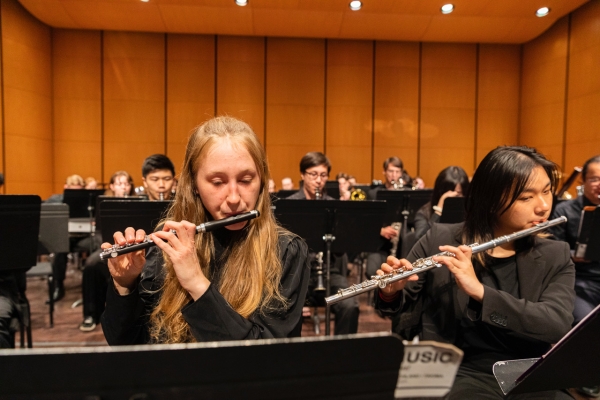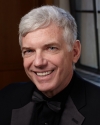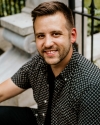The UW Wind Ensemble (Timothy Salzman, director) and Symphonic Band (Shaun Day, director) present “Uplift,” a program of music by Jack Stamp, Melissa Wang, Salvador Alan Jacobo, Vincent Persichetti, Steven Bryant, Sergei Rachmaninoff, and others.
Program
UW Symphonic Band
Shaun Day, director
Gavorkna Fanfare (1991): Jack Stamp (b. 1954)
Hailey Kepple, conductor
Hymn to a Blue Hour (2010): John Mackey (b. 1973)
Plagued (2023): Melissa Wang (b. 1999)
World premiere
Psalm for Band (1954): Vincent Persichetti (1915-1987)
UW Wind Ensemble
Timothy Salzman, Director
Ecstatic Fanfare (2012): Steven Bryant (b. 1972)
Shaun Day, conductor
Masks and Machines (2015): Paul Dooley (b. 1983)
I.
II.
III.
Roger Wu Fu and David Stewart, conductors
AMEN! Carlos Simon
I. Lively
II. Soulfully
III. Mysteriously
Program Notes
Gavorkna Fanfare, a work written for and dedicated to Eugene Corporon and the University of Cincinnati College-Conservatory of Music, opens with a thunderous theme highlighting the high brass section. The initial idea immediately transitions into a fugue with ornamenting entrances throughout the ensemble, creating a four-part counterpoint with minimalist accompaniment. The opening motif returns in the coda and the work concludes with an electrifying finish.
The blue hour is an oft-poeticized moment of the day - a lingering twilight that halos the sky after sundown but before complete darkness sets in. It is a time of day known for its romantic, spiritual, and ethereal connotations, and this magical moment has frequently inspired artists to attempt to capture its remarkable essence. This is the same essence that inhabits the sonic world of John Mackey’s Hymn to a Blue Hour. The title contains two strongly suggestive implications. First is hymnody, which implies a transcendent and perhaps even sacred tone. Second, the color blue has an inevitable tie to American music. This work is not directly influenced by the blues, per se, but there is frequently a sense of nostalgic remorse and longing throughout the piece - an overwhelming sadness that is the same as the typically morose jazz form. Blue also has a strong affiliation with nobility, authority, and calmness. (program note by Jake Wallace)
Plagued examines the concepts, environmental sounds, and emotional journey of the Biblical plagues of Egypt. The composition explores coordinated physical movements representing the loss of sanity resulting in fear, craze, and alertness. Additionally, the piece explores vocal sound effects such as the tongue roll “krrrrr” weaving with percussion instruments sounding similar to the voiced gesture and the unvoiced “t” “k” sound effects representing a clock ticking. This piece was written for and premiered by the University of Washington Symphonic Band. (program note by composer)
Psalm for Band is a piece constructed from a single germinating harmonic idea. There are three distinct sections - a sustained chordal mood, a forward-moving chorale, and a paean culmination of the materials. Extensive use is made of separate choirs of instruments supported by thematic rhythms in the tenor and bass drums. Psalm was selected for performance at the CBDNA Convention in December 1952 as one of the eight most outstanding compositions for a band written in the previous several years. (program note by composer)
Steven Bryant studied composition with John Corigliano at The Juilliard School, Cindy McTee at the University of North Texas, and Francis McBeth at Ouachita University. The son of a professional trumpeter and music educator, he strongly values music education, and his creative output includes several works for young and developing musicians. He is particularly known in the wind ensemble world for Ecstatic Waters and his monumental 2019 work, The Automatic Earth. Recent works include Concerto for Saxophone for Joseph Lulloff and the Michigan State University Wind Symphony (winner of the 2014 American Bandmasters Sousa Ostwald Award), and Concerto for Trombone for New York Philharmonic principal trombonist Joseph Alessi and the Dallas Wind Symphony.
Ecstatic Fanfare unfolds with a flurry that can best be described as aggressive jubilation that winds down into a quiet, pure, pastoral melody marked by descending fourths in the clarinets. The use of open harmonies and descending fourths provide a sense of innocence and simplicity reminiscent of the music of Aaron Copland. This quiet music is eventually transformed into a powerful statement by the horns, marked “aggressive and celebratory.” This moment of celebration explodes into elation and the work rallies toward an energetic, powerful conclusion. (program note by composer)
With the passionate guidance of two musically progressive parents, Paul Dooley began his musical career by playing in a wide range of genres: from drum set and piano in rock and jazz groups to orchestral percussion. At age 12, he began studying composition and improvisation with Doc Collins, and later with Charles Sepos. Mr. Dooley earned a degree in music composition, and a second bachelors degree in mathematics at the University of Southern California, where his mentors included Frank Ticheli, Stephen Hartke and Frederick Lesemann. Dooley is currently completing a doctorate in composition at the University of Michigan, where he works primarily with composers Michael Daugherty, Bright Sheng and Evan Chambers. Dooley is a Lecturer in Performing Arts Technology at the University of Michigan. Mr. Dooley's path has embraced not only his Western Classical heritage, but also a cross-cultural range of contemporary music, dance, art, technology, and the interactions between the human and natural worlds. His music has been described as "impressive and beautiful" by American composer Steve Reich.
Masks and Machines was commissioned by a consortium of wind bands organized by Timothy Shade in honor of Gary Green's retirement from the Frost School of Music at the University of Miami. The work is inspired by the early twentieth century works of Bauhaus artist Oskar Schlemmer, and the Neoclassical music of Igor Stravinsky. I admire the simplicity of shapes and color in Schlemmer's works such as the Bauhaus Stairway and Triadic Ballet as well as the renaissance and baroque musical influences in Stravinsky's Pulcinella. Masks and Machines contains three contrasting character pieces featuring renaissance brass music, Baroque fortspinnung in virtuosic mallet percussion, lush oboe, clarinet and bassoon solos, and machine-like flute rips. (program note by composer)
“My dad, he always gets on me. He wants me to be a preacher, but I always tell him, ‘Music is my pulpit. That’s where I preach,’” Carlos Simon reflected for The Washington Post’s ‘Composers and Performers to Watch in 2022’ list. Having grown up in Atlanta, with a long lineage of preachers and connections to gospel music to inspire him, Simon proves that a well-composed song can indeed be a sermon. His compositions span genres – jazz, gospel, and contemporary classical music are noticeable influences – and can be found everywhere from film scores to concert music. Simon is the current Composer-in-Residence for the John F. Kennedy Center for the Performing Arts and frequently writes for the National Symphony Orchestra and Washington National Opera, with the 2022/23 season seeing premieres with Boston Symphony Orchestra, Detroit Symphony Orchestra, Brooklyn Art Song Society and Minnesota Orchestra – a large-scale tribute to George Floyd and the ongoing movement for racial justice. These follow recent commissions from the likes of New York Philharmonic and Los Angeles Philharmonic, and performances from Baltimore Symphony Orchestra, London Symphony Orchestra, and American Ballet Theatre.
AMEN! (2017) was commissioned by the University of Michigan Symphony Band and is a homage to my family's four generational affiliation with the Pentecostal church. My intent is to re-create the musical experience of an African American Pentecostal church service that I enjoyed being a part of while growing up in this denomination. Pentecostal denominations, such as Church of God in Christ (C.O.G.IC.), Pentecostal Assemblies of God, Apostolic, Holiness Church, among many others, are known for their exuberant outward expressions of worship. The worship services in these churches will often have joyous dancing, spontaneous shouting, and soulful singing. The music in these worship services is a vital vehicle in fostering a genuine spiritual experience for the congregation. The three movements in AMEN! are performed without break to depict how the different parts of a worship service flows into the next. In the first movement, I’ve imagined the sound of an exuberant choir and congregation singing harmoniously together in a call and response fashion. The soulful second movement quotes a gospel song, "I'll Take Jesus For Mine” that I frequently heard in many services. The title, AMEN!, refers to the plagal cadence or “Amen" cadence (IV-I), which is the focal point of the climax in the final movement. Along with heavily syncopated rhythms and interjecting contrapuntal lines, this cadence modulates up by half step until we reach a frenzied state, emulating a spiritually heightened state of worship. (program note by composer)
UNIVERSITY OF WASHINGTON SYMPHONIC BAND
|
Biographies
University of Washington Professor Emeritus Timothy Salzman served as Professor of Music/Director of Concert Bands and conductor of the UW Wind Ensemble from 1987 to 2025. When he was appointed to the position there were 11 students enrolled in one UW wind band – in his final year there were 335 enrolled in five bands. Former graduate wind conducting students of Professor Salzman have obtained positions at 73 universities and colleges throughout the United States and include past presidents of the American Bandmasters Association and the College Band Directors National Association as well as Jiannan Cheng, cover conductor for the Philadelphia Orchestra. During his tenure at the UW the band program was involved in commissioning and, in certain cases, the premiering of 38 new works for wind ensemble and undertook many concert tours including seven to Asia. From 1978 to 1983 he was band director in the Herscher, Illinois, public school system where the band program received numerous state, regional and national awards in solo/ensemble, concert and marching band competition. Immediately prior to his UW appointment he served for four years as Director of Bands at Montana State University where he founded the MSU Wind Ensemble and ‘Spirit of the West’ Marching Band. Professor Salzman holds degrees from Wheaton (IL) College, and Northern Illinois University, and studied privately with world-renown wind instrument pedagogue Arnold Jacobs, former tubist of the Chicago Symphony Orchestra. He has numerous publications for bands with the C. L. Barnhouse, Arranger's Publications, Columbia Pictures, Hal Leonard Publishing and Nihon Pals publishing companies, and has served on the staff of new music reviews for The Instrumentalist magazine. Professor Salzman has been a conductor, adjudicator, arranger, or consultant for bands throughout the United States and in Canada, England, France, Russia, South Korea, Indonesia, Thailand, Singapore, the Philippines, China, and Japan, a country he has visited twenty-one times. He has traveled to China twelve times where he served as visiting professor at the China Conservatory, given master classes for numerous wind bands, and conducted several ensembles including the Shanghai Wind Orchestra, the People's Liberation Army Band, the Beijing Wind Orchestra, The China Conservatory Wind Ensemble and the Tsinghua University Band in multiple concerts. He also served on three occasions as an adjudicator for the Singapore Youth Festival National Concert Band Championships. He has conducted several of the major military bands in the United States including a 2019 world premiere with 'The President's Own' United States Marine Band. He was compiling editor and co-author (with several current and former UW graduate students) of A Composer's Insight: Thoughts, Analysis and Commentary on Contemporary Masterpieces for Wind Band, a five-volume series of books on contemporary wind band composers. The forwards to each volume were written by five Pulitzer Prize-winning composers. He was also a contributing author to a recent book (2022) about his former teacher entitled Arnold Jacobs: His Artistic and Pedagogical Legacies in the 21st Century. Professor Salzman is an elected member of the American Bandmasters Association and is a past president of the Northwest Division of the College Band Directors National Association. He is an elected member of the Drum Corps International Hall of Fame as well as the Santa Clara (CA) Vanguard and Cavaliers (IL) Drum and Bugle Corps Hall of Fame for his work as an arranger and brass instructor. In 2009 Nihon Pals, a music education resource company based in Osaka, Japan, released a set of instructional DVDs regarding ensemble musicality featuring the UW Wind Ensemble. The University of Washington hosted the 2011 National Conference of the College Band Directors National Association.
As a conductor, trumpet player, and educator, Shaun Day enjoys sharing his passion by working with a variety of music ensembles and creating a positive community through music. Shaun is completing his DMA in Instrumental Conducting at the University of Washington where he is the director and conductor for the UW Symphonic Band, and the associate conductor for the UW Wind Ensemble. He is also serving as the Conductor and Artistic Director for the Mukilteo Community Orchestra and enjoys connecting with local music educators in the Seattle area. Shaun continues to work as an ensemble clinician, guest conductor, and as a presenter at music education conferences, including the Washington Music Educators Association (WMEA) State Conference.
Originally from Cincinnati, Ohio, Shaun earned his BM in Music Education with a concentration in trumpet performance, and his MM in Conducting from the University of Cincinnati, College-Conservatory of Music (CCM). During that time, he was the manager of the CCM Wind Symphony, CCM Brass Choir, the University Commencement Band, and a Graduate Assistant of the University of Cincinnati Bearcat Band. Shaun also served as the Associate Conductor of the University of Cincinnati Symphony Orchestra and Guest Conductor for the Fillmore Philharmonic Brass (OH).
Before completing his MM, Shaun was the assistant band director at Turpin High School in Cincinnati. His duties included directing the high school concert bands, directing the high school jazz program, the musical theatre pit orchestra, assisting and directing the high school marching band program, and directing the 5th-12th concert bands. His professional affiliations include the College Band Directors National Association (CBDNA), Washington Music Educators Association (WMEA), and the Ohio Music Education Association (OMEA) where he served as the District XIV Secretary and Treasurer from 2016-2018.


